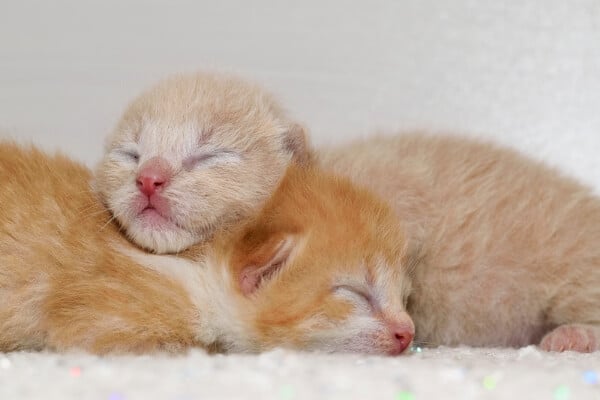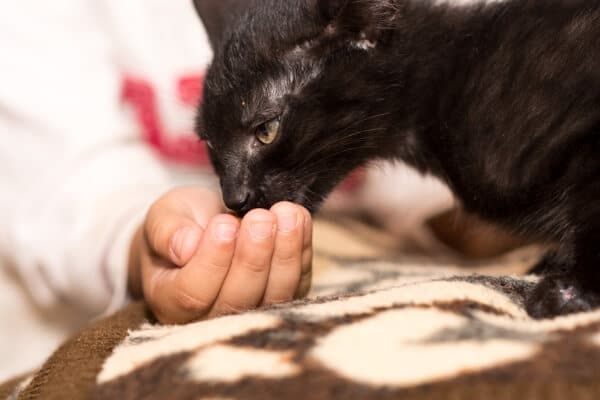New Cat Not Eating (Reasons & What To Do)

Troubled by your new feline friend’s finicky appetite? It’s not uncommon for a cat to be a picky eater, but when your new furball refuses to dine, it can be worrisome. Understanding the reasons for this behavior can help to proffer solutions to their non-eating habit.
When a new cat won’t eat, several reasons could be causing this reluctance. Stress from adapting to a new environment, changes in surroundings, and unfamiliar faces can overwhelm your feline friend. Moreover, an abrupt diet change or the presence of other pets may also affect her feeding habit. To encourage them to eat, consider keeping them in a quiet room alone initially, providing a safe and secure space, and tempting their appetite with treats or wet food, as these are often more appealing to cats. Make sure they have access to fresh water and closely monitor their eating habits.
If the issue persists, consult a veterinarian to rule out any underlying health problems. A thorough examination can identify potential medical reasons for their decreased appetite. Be patient and understanding during this transition period, as introducing a new cat to a household takes time and gentleness
Why Is My New Cat Not Eating?
There are several reasons why your new cat might not be eating. Understanding them can help you address the issue and find the best approach to encourage your new cat to eat. Some of these reasons are listed below.
1. Stress From The New Environment
Cats are highly sensitive creatures, and moving to a new environment can be an incredibly stressful experience for them. The change in surroundings, introduction to unfamiliar scents, and the presence of new people can leave them feeling anxious and uncertain. As a result, they may become hesitant to eat as their instinct is to be cautious and on guard in unfamiliar territories.
2. Sudden Diet Change
Cats are known for being creatures of habit, and abrupt changes to their diet can be unsettling for them. Switching to a new type or brand of food without a gradual transition can lead to digestive upset and a reluctance to eat. Cats prefer familiar scents and flavors, so introducing a new food without allowing them time to adjust can lead them to reject it altogether.
3. Presence of Other Pets
If you have other pets in the household, the new cat may feel threatened or intimidated, especially if they are not used to living with other animals. Competition for resources like food and territory can cause stress and anxiety, leading to a reduced appetite. The new cat might feel the need to establish its place in the hierarchy before feeling comfortable enough to eat peacefully.
4. Medical Issues
A decrease in appetite can be an early sign of an underlying health problem in cats. Dental issues, gastrointestinal troubles, infections, or other medical conditions can cause discomfort, making eating a painful or unpleasant experience. In such cases, the cat may avoid food altogether or eat significantly less than usual.
5. Anxiety or Fear
Some cats are naturally more timid, and the change in environment can trigger anxiety or fear responses. The new sights, sounds, and smells can be overwhelming for them, and they may retreat or hide, avoiding food in the process. It’s crucial to create a quiet and secure space for such cats, allowing them to acclimate at their own pace.
6. Recent Vaccination
After receiving vaccinations, cats might experience a temporary loss of appetite. Vaccines stimulate the immune system, and in some cases, cats may feel under the weather or slightly lethargic, leading them to skip meals. This response is usually short-lived and should resolve within a day or two.
7. Change in Feeding Routine
Cats thrive on consistency, and even minor changes in their feeding routine, such as the timing of meals or the location of food bowls, can be unsettling for them. Such alterations may disrupt their sense of security and routine, causing them to be hesitant or disinterested in eating.
Providing a calm and supportive environment, gradual transitions, and seeking veterinary attention when needed can ensure your feline friend’s well-being and a healthy appetite.
My New Cat Is Hiding And Not Eating: Why & What To Do.
Moving to a new environment can be a daunting experience for cats, causing them significant stress and anxiety. The unfamiliar surroundings, strange smells, different sounds, and sudden change in routine can be overwhelming, leading your new feline friend to retreat and hide to feel safe. This hiding behavior is a natural self-protective response as they try to cope with new and unfamiliar surroundings. Additionally, some cats have naturally shy or introverted personalities, making them more prone to seek hiding spots when faced with new situations or people.
Furthermore, the presence of other pets in the household can contribute to your cat’s hiding behavior. If you have other animals, your new cat may feel intimidated or overwhelmed by their presence,
To help your new cat, create a safe and quiet space where they can feel secure. Designate a secluded area in your home and offer hiding spots like boxes or cozy beds and allow your cat to explore and come out of hiding at their own pace. Avoid forcing them to interact as this may increase their anxiety. Be patient and understanding, giving them time to adjust to their new environment.
Also, gradual introductions are essential, especially if you have other pets. Introduce them slowly and carefully, ensuring a calm and controlled environment, this will allow your new cat to get used to the presence of other animals. You can also stick to a consistent feeding schedule and environment to provide your cat with a sense of stability and routine. Offer enticing treats or wet cat food to encourage them to eat and gradually transition to any new diet to avoid abrupt changes that may lead to food aversion. Finally, it’s crucial to monitor your cat’s health closely, and if their hiding and lack of appetite persist, consult a veterinarian to rule out any underlying health issues.
What Should I Do If My New Cat Is Not Eating?
If your new cat is not eating, it’s essential to take prompt action to ensure their well-being. Here are some steps to follow:
1. Monitor and Observe: Keep a close eye on your cat’s eating habits and behavior. If they have not eaten for more than 24 hours or show signs of illness, such as lethargy, vomiting, or diarrhea, seek veterinary attention immediately.
2. Create a Calm Environment: Moving to a new home can be stressful for cats. Provide a quiet and secure space where they can feel safe and reduce environmental stressors. Avoid loud noises or sudden changes that might make them anxious.
3. Stick to Familiar Food: If you know what food they were eating before, try to provide the same or a similar type of food initially. Gradually transitioning to a new diet can prevent food aversion.
4. Offer Tempting Food and Treats: To entice your cat to eat, offer their favorite treats or wet cat food, which is often more appealing due to its strong smell and taste.
5. Check for Dental or Health Issues: Dental problems or underlying health issues can cause discomfort, leading to a loss of appetite. If you notice any signs of oral pain or suspect health problems, consult a veterinarian.
7. Avoid Overwhelming Them: Allow your new cat to adjust to their surroundings at their own pace. Avoid overwhelming them with attention or trying to force them to come out of their shell, they will do so on their own.
8. Gradual Introduction to Other Pets: If you have other pets, introduce them gradually to your new cat to avoid stress and potential conflicts that could impact their eating habits.
Remember that every cat is unique, and some may take longer to adjust than others. If your new cat’s eating problem persists or if you are concerned about its health, seek professional advice from a veterinarian.
How Long Will A Newly Adopted Cat Go Without Eating?
All cats can survive without eating for one to two weeks as long as there’s access to water. However, it’s important to note that such a prolonged period (of more than 24 hours) without food is not healthy and can pose risks to the cat’s well-being. Cats are adaptable and can draw on their fat reserves for energy during short periods of food scarcity.
Nevertheless, it’s crucial to closely monitor the cat’s behavior and consult a veterinarian if the lack of appetite persists. Stress and anxiety in the new environment can affect the cat’s eating habits, so providing a calm space and familiar food options may encourage them to eat. Remember that seeking veterinary advice is essential if the cat continues to refuse food beyond a few days to address any potential health issues.
How Long Does It Take For A New Cat To Start Eating And Drinking?
The time it takes for a new cat to start eating and drinking can vary significantly depending on the individual cat and the circumstances surrounding their introduction to a new environment. Some cats may begin eating and drinking within a few hours of arrival, while others may take several days to feel comfortable enough to do so. The key factor in this process is the cat’s level of stress and anxiety in their new surroundings.
In general, it’s crucial to give your new cat time to acclimate at their own pace. Moving to a new home is a significant change, and cats are naturally cautious creatures, especially when faced with unfamiliar surroundings and people. It’s not uncommon for them to hide initially and refrain from eating or drinking while they assess their new environment and feel secure.
To help expedite the process, provide hiding spots and comfortable bedding where they can retreat and feel safe. Offer their favorite treats or wet cat food to entice them to eat and ensure fresh water is readily available at all times. Gradually introduce yourself and other household members to your new cat, using gentle and reassuring interactions to build trust and help them feel more at ease.
Cat Only Licks Gravy Off Wet Food And Won’t Eat The Meat. What Should I Do?
New Cat Not Eating Much But Acting Normal
If your new cat is not eating much but is otherwise acting normal, there could be several reasons for their reduced appetite. It’s essential to pay attention to their behavior and monitor any other potential signs of distress or health issues.
1. Stress and Adjustment: Moving to a new environment can be stressful for cats, and a decreased appetite is a common response to the change. They may need time to acclimate and feel secure in their new surroundings before their eating habits normalize.
2. Not Liking the Taste of the Food: Cats can be picky eaters, and if they don’t like the taste of the new food, they may refuse to eat. Trying different brands or flavors might help find a more appealing option.
3. Dental Issues: Dental problems can cause discomfort or pain while eating, leading to a reduced appetite. Examine your cat’s mouth for any signs of redness, swelling, or difficulty in chewing.
4. Side Effects of Medications: If your cat is on medication, some drugs may cause a temporary loss of appetite as a side effect. Check with your veterinarian to see if this could be the cause.
5. Recent Vaccination: If your cat has recently received vaccinations, he might experience a temporary loss of appetite as a mild side effect. This is usually short-lived and should resolve on its own.
6. Underlying Health Issues: While your cat is acting normal, it’s essential to remain vigilant for any subtle changes in behavior or other signs of illness. A decrease in appetite can be an early indicator of underlying health problems, such as gastrointestinal issues or infections.
What Do You Feed A Cat That Won’t Eat?
There are several strategies you can employ to entice a cat that won’t eat to do so. One effective approach is to offer commercial canned foods with strong aromas. Canned foods are often more appealing to cats than dry kibble due to their higher palatability. Experiment with different flavors and textures to find the one that your cat prefers.
Another option is to add chicken broth to their meals. The savory aroma and taste of chicken broth can make the food more enticing, encouraging the cat to eat. However, ensure that the chicken broth is free of any added salt or seasonings, as these can be harmful to felines. You can prepare homemade chicken broth or opt for store-bought options that are safe for cats.
Additionally, slightly warming the food can release appealing aromas, making it more enticing to a reluctant eater. Cats are sensitive to food temperature, and offering it slightly warmed to room temperature can enhance its appeal. Be cautious though, not to make the food too hot, as cats prefer their meals at a slightly warm or room temperature level.
How Long Does It Take For A Newly Adopted Cat To Adjust
A newly adopted cat typically takes no more than a week or two to adjust to their new environment. During this time, you’ll notice various actions and behaviors that indicate their growing comfort and readiness to explore.
In the initial days, the newly adopted cat may spend most of their time hiding or seeking out quiet, secluded spots in the home. However, as they start feeling more secure, you may notice them peeking out from their hiding spots or cautiously venturing into other areas of the house. They may start to explore during the quieter hours of the day when the environment feels less overwhelming.
A cat ready to explore may also display curiosity toward their surroundings. They might be intrigued by new scents, toys, or objects in the home, and you may catch them investigating corners, shelves, or other nooks they hadn’t explored before. As they grow more comfortable, they might engage in playful behavior, batting at toys, or even showing interest in interactive play with their human family members.
Final Thoughts
When you have a new cat that is not eating, it’s essential to approach the situation with patience and understanding. There could be various reasons behind their lack of appetite, such as stress, anxiety, or the need to adjust to their new environment or diet.
Offering commercial canned foods with strong aromas, adding cat-safe chicken broth to their meals, and slightly warming the food can help entice them to eat. Remember to consult a veterinarian if their lack of appetite persists to rule out any underlying health issues.
Creating a calm and supportive environment is crucial to help your new feline companion feel at ease and encourage them to resume their regular eating habits. With time and proper care, your cat will likely settle into their new home and regain their appetite.
Read related posts about





